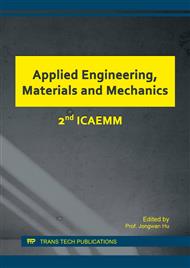p.94
p.99
p.109
p.114
p.119
p.125
p.130
p.143
p.149
Preparation of UHPC with Fly Ash Replaced by Rich-Silicon Iron Ore Tailing Powder
Abstract:
In order to raise up the the rate of multipurpose utilization of rich-silicon iron ore tailing (IOTP for short) and the preparation of ultra-high performance concrete(UHPC for short), the influence rules and mechanism of rich-silicon iron ore tailing powder replacing fly ash in UHPC were studied, the influences of different specific surface area and dosage of IOTP replacing fly ash on its strength and liquidity were tested. Moreover, the pore structure and hydration products morphology of UHPC were tested by MIP and SEM methods, respectively. The results show that when fly ash replaced by IOTP, the liquidity of UHPC will be increased. When alternative content of IOTP is less than 10%, proper specific surface area of IOTP can improve the strength and pore structure, it can get the best result when the alternative content is 5% and the specific surface area is 588m2/kg. However, when alternative content of IOTP is 15% or more, all of these properties of UHPC become worse. It proves that IOTP can be used in the preparation of UHPC and improve the properties of UHPC.
Info:
Periodical:
Pages:
119-124
Citation:
Online since:
October 2017
Authors:
Keywords:
Price:
Сopyright:
© 2017 Trans Tech Publications Ltd. All Rights Reserved
Share:
Citation:


